This Peculiar Portrait Showcases NGC 1999, A Reflection Nebula In The Constellation Orion. NGC 1999 Is

This peculiar portrait showcases NGC 1999, a reflection nebula in the constellation Orion. NGC 1999 is around 1,350 light-years from Earth and lies near the Orion Nebula, the closest region of massive star formation to Earth. NGC 1999 itself is a relic of recent star formation – it is composed of debris left over from the formation of a newborn star.
Credit: ESA/Hubble & NASA, ESO, K. Noll
More Posts from Of-finite-jurisdiction and Others

Zeta Ophiuchi: A Star With a Complicated Past via NASA https://ift.tt/78Esywl
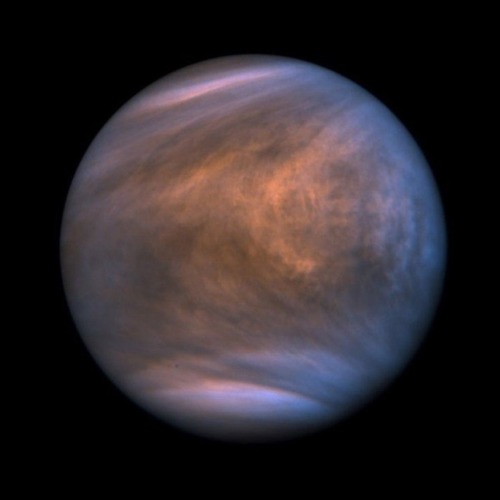

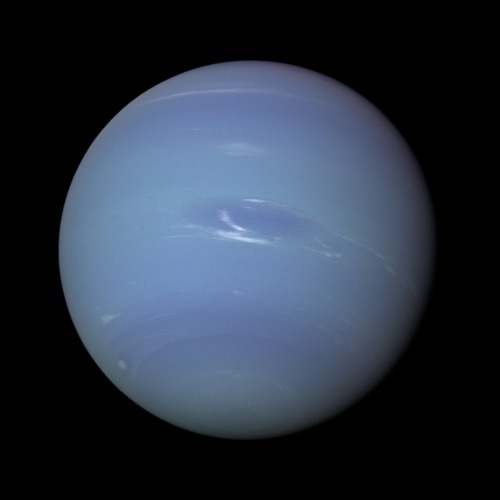
Venus, Callisto (Jupiter’s moon), Neptune

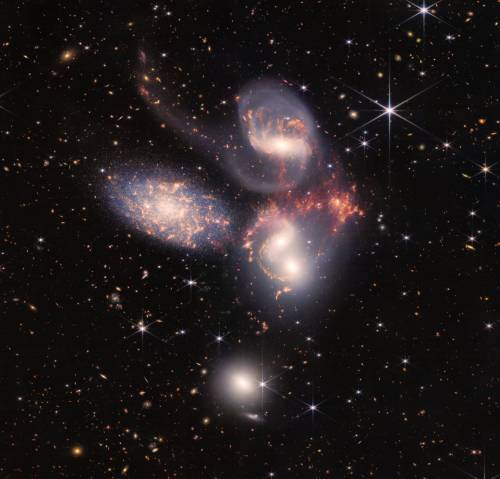
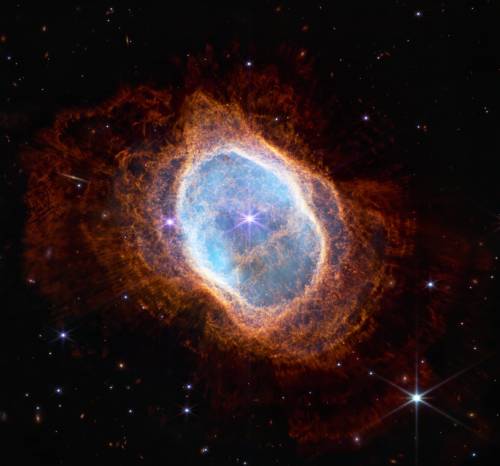
NASA’s Webb Space Telescope Reveals Astounding, Unprecedented Views of the Universe
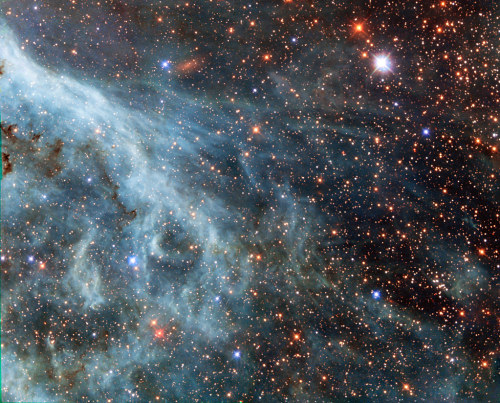
Turquoise Plumes in the Large Magellanic Cloud by NASA’s Marshall Space Flight Center

Space Station Silhouette on the Moon : What’s that unusual spot on the Moon? It’s the International Space Station. Using precise timing, the Earth-orbiting space platform was photographed in front of a partially lit gibbous Moon last month. The featured composite, taken from Payson, Arizona, USA last month, was intricately composed by combining, in part, many 1/2000-second images from a video of the ISS crossing the Moon. A close inspection of this unusually crisp ISS silhouette will reveal the outlines of numerous solar panels and trusses. The bright crater Tycho is visible on the upper left, as well as comparatively rough, light colored terrain known as highlands, and relatively smooth, dark colored areas known as maria. On-line tools can tell you when the International Space Station will be visible from your area. via NASA

NGC 1365, Heart of the Galaxy
So, this beautiful image from the James Webb telescope:

This is the Cliffs of Creation located in the Carina Nebula, approximately 7,600 lights years away.
We can see individual stars being born, eventually they will heat up enough to burn up their surrounding gases and dust.
This is the full Carina Nebula:

So... Where in this nebula are our beautiful cliffs?
Here:

Previously unseen, the James Webb has highlighted this amazing small bubble.
Edited: previous image I had highlighted the wrong area.

Chamaeleon Dark Nebulas : Sometimes the dark dust of interstellar space has an angular elegance. Such is the case toward the far-south constellation of Chamaeleon. Normally too faint to see, dark dust is best known for blocking visible light from stars and galaxies behind it. In this four-hour exposure, however, the dust is seen mostly in light of its own, with its strong red and near-infrared colors giving creating a brown hue. Contrastingly blue, the bright star Beta Chamaeleontis is visible just to the right of center, with the dust that surrounds it preferentially reflecting blue light from its primarily blue-white color. All of the pictured stars and dust occur in our own Milky Way Galaxy with – but one notable exception: the white spot just below Beta Chamaeleontis is the galaxy IC 3104 which lies far in the distance. Interstellar dust is mostly created in the cool atmospheres of giant stars and dispersed into space by stellar light, stellar winds, and stellar explosions such as supernovas. via NASA
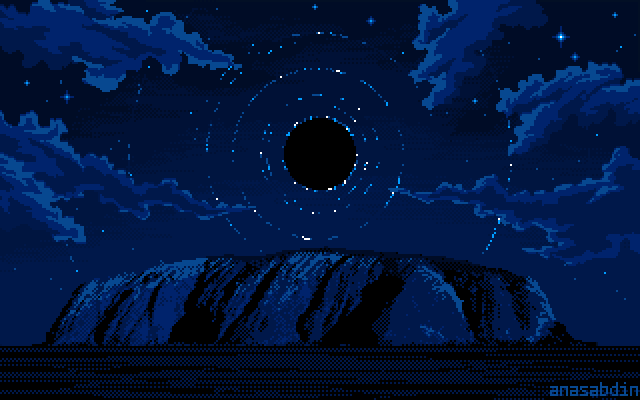
Uluru blackh●le rise, me, pixel art, 2022
It wrinkles my brain that Jupiter’s moon Europa has oceans that are sixty miles deep, while Earth’s oceans only reach seven miles deep at most. I’m willing to bet good money that there’s life in Europa’s oceans. Like five bucks. You hear me, NASA? I bet you five bucks that there’s life on Europa… Now that there’s money and reputation on the line, I bet they send a mission there real quick.
-
 mirillel reblogged this · 2 months ago
mirillel reblogged this · 2 months ago -
 mirillel liked this · 3 months ago
mirillel liked this · 3 months ago -
 dvoidroid liked this · 3 months ago
dvoidroid liked this · 3 months ago -
 searchingforthedoctor reblogged this · 3 months ago
searchingforthedoctor reblogged this · 3 months ago -
 searchingforthedoctor liked this · 3 months ago
searchingforthedoctor liked this · 3 months ago -
 raygard-elvets liked this · 3 months ago
raygard-elvets liked this · 3 months ago -
 riding-with-the-wild-hunt reblogged this · 3 months ago
riding-with-the-wild-hunt reblogged this · 3 months ago -
 ultramusix liked this · 3 months ago
ultramusix liked this · 3 months ago -
 voidstation reblogged this · 3 months ago
voidstation reblogged this · 3 months ago -
 nohriantomatoes reblogged this · 3 months ago
nohriantomatoes reblogged this · 3 months ago -
 lexieandsloan13 reblogged this · 3 months ago
lexieandsloan13 reblogged this · 3 months ago -
 kneesntoess reblogged this · 3 months ago
kneesntoess reblogged this · 3 months ago -
 vaguecaninething reblogged this · 3 months ago
vaguecaninething reblogged this · 3 months ago -
 eitherore liked this · 4 months ago
eitherore liked this · 4 months ago -
 xrosettex reblogged this · 4 months ago
xrosettex reblogged this · 4 months ago -
 maester-cressen reblogged this · 4 months ago
maester-cressen reblogged this · 4 months ago -
 harrys-strutting-dad liked this · 4 months ago
harrys-strutting-dad liked this · 4 months ago -
 vavaharrison liked this · 4 months ago
vavaharrison liked this · 4 months ago -
 blackbetha reblogged this · 4 months ago
blackbetha reblogged this · 4 months ago -
 de-launaie liked this · 4 months ago
de-launaie liked this · 4 months ago -
 echoofthemusic liked this · 4 months ago
echoofthemusic liked this · 4 months ago -
 maviacomic liked this · 4 months ago
maviacomic liked this · 4 months ago -
 nicodiangelone liked this · 4 months ago
nicodiangelone liked this · 4 months ago -
 oceansplosion liked this · 4 months ago
oceansplosion liked this · 4 months ago -
 matrose reblogged this · 4 months ago
matrose reblogged this · 4 months ago -
 notjamesyang liked this · 4 months ago
notjamesyang liked this · 4 months ago -
 flawlesschowchow reblogged this · 4 months ago
flawlesschowchow reblogged this · 4 months ago -
 flawlesschowchow liked this · 4 months ago
flawlesschowchow liked this · 4 months ago -
 constellies reblogged this · 4 months ago
constellies reblogged this · 4 months ago -
 often-lurking liked this · 4 months ago
often-lurking liked this · 4 months ago -
 weird-is-all-ive-got reblogged this · 4 months ago
weird-is-all-ive-got reblogged this · 4 months ago -
 owlways-sleepy reblogged this · 4 months ago
owlways-sleepy reblogged this · 4 months ago -
 owlways-sleepy liked this · 4 months ago
owlways-sleepy liked this · 4 months ago -
 mechanicalsalmon liked this · 4 months ago
mechanicalsalmon liked this · 4 months ago -
 weird-is-all-ive-got liked this · 4 months ago
weird-is-all-ive-got liked this · 4 months ago -
 shewholistens reblogged this · 4 months ago
shewholistens reblogged this · 4 months ago -
 nechronica liked this · 4 months ago
nechronica liked this · 4 months ago -
 p41nm0ng3r reblogged this · 4 months ago
p41nm0ng3r reblogged this · 4 months ago -
 p41nm0ng3r liked this · 4 months ago
p41nm0ng3r liked this · 4 months ago -
 e30-obsession liked this · 4 months ago
e30-obsession liked this · 4 months ago -
 razzberryblanket liked this · 4 months ago
razzberryblanket liked this · 4 months ago -
 hydrathermal liked this · 4 months ago
hydrathermal liked this · 4 months ago -
 eldritchhermitsir reblogged this · 4 months ago
eldritchhermitsir reblogged this · 4 months ago -
 itsmeezra reblogged this · 4 months ago
itsmeezra reblogged this · 4 months ago -
 itsmeezra liked this · 4 months ago
itsmeezra liked this · 4 months ago -
 gaobing reblogged this · 4 months ago
gaobing reblogged this · 4 months ago -
 gaobing liked this · 4 months ago
gaobing liked this · 4 months ago -
 futuristicallyclever42 liked this · 4 months ago
futuristicallyclever42 liked this · 4 months ago

Finn OFJ’s space blog. Do you love space?? you better. or else
39 posts